U.S. Department of Transportation
Federal Highway Administration
1200 New Jersey Avenue, SE
Washington, DC 20590
202-366-4000
FHWA > Policy > Economic Returns From Transportation Investment
A national debate is gathering momentum over whether the U.S. economy can grow faster than it has over the past two decades. During the 1970s and 1980s, the economy's rate of growth slowed dramatically from its historical average. Between 1870 and the early 1970s, the best data show that the American economy grew at an average rate of nearly 3.5% a year. Since 1973, the economy has grown at only 2.4% a year.
Whether the nation is better off in the future depends on whether the rate of growth of productivity can be raised. Productivity is the main source of economic growth and a rising standard of living. Its growth has slowed even more dramatically over the past two decades than did overall growth. Labor productivity — the output of goods and service per hour of work — grew at a rate of more than 2% a year since just after the Civil War. Since 1973, it has managed to grow at only 1% a year. Total factor productivity—the output per unit of labor and capital—has slowed down to a similar degree.
Had productivity grown at its long-term rate since 1973, another $13 trillion in national income would have been produced by the economy. As a consequence, tax revenues would have risen so much that there would be no federal deficit today. In fact, at current levels of federal spending, there would be a substantial budget surplus.
Investments in infrastructure, particularly transportation projects, may have significant impacts upon economic productivity. Governments make investments in transportation facilities to support development, to spur economic growth, to alleviate existing deficiencies, or to increase public convenience. In the 19th century, the large positive economic value derived from investments in transportation systems was taken to be self-evident, and major investments in roads, railroads, and canals were made on this basis. As the U.S. developed, transportation investments were used to transform the economic environment profoundly. Similarly, historians attribute the Industrial Revolution to various transportation investments that preceded it. Today, developing nations view transportation investments as key ingredients for economic development and growth.
No one living in contemporary America can overlook the profound changes brought about by the Interstate Highway System on where people live, work, and shop. It has expanded the range over which goods can be marketed, has created opportunities for economies of scale and for increased specialization, and has brought the efficiencies of just-in-time inventory systems to businesses across the land. Although the impacts of the system surround us, few attempts have been made to estimate the overall, program-wide economic value of public investments in transportation facilities.

Rodney Slater discusses the rates of return from transportation investments
Because of the importance of productivity growth to the economy, and in anticipation of the reauthorization of the nation's surface transportation programs next year, the Federal Highway Administration (FHWA) and the American Association of State Highway and Transportation Officials (AASHTO), through the National Cooperative Highway Research Program (NCHRP), asked the Eno Transportation Foundation to call a conference of transportation experts and policy makers from the public and private sectors and academia to discuss whether transportation infrastructure investment can play a critical part in improving America's productivity.

(L to R) Jose Gomez-Ibanez of Harvard University, Beth Pinkston of the Congressional Budget Office, and Theresa Smith of FHWA
In the 1950s, the rate of growth of highway capital surged. After declining slightly in 1950 and 1951, the capital stock grew at an annual rate of 6.2% until 1959. But beginning in the 1960s and on through the 1970s, the rate of growth slowed continuously. Since 1982, highway capital stock has been growing at an average rate of 1.2% a year.
This increased rate of growth has not kept pace with the increase in demand for highway transportation. The slow rate of investment has contributed to increased congestion and poor maintenance. It has also resulted in fewer large-scale transportation projects, and required proportionately more funding from state and local levels of government for transportation improvements.
But has the lower rate of investment in transportation infrastructure since the 1950s contributed significantly to the general slowdown in productivity growth? Can raising the rate of investment in transportation infrastructure enhance overall productivity for the entire nation? The Eno policy forum addressed these fundamental questions.
The starting place for this discussion was a new econometric study by M. Ishaq Nadiri of New York University and the National Bureau of Economic Research and Theofanis P. Mamuneas of the University of Cyprus. It is a comprehensive analysis of how investment in highway infrastructure affects the nation's output, the commercial sector's costs of doing business, and private sector productivity in general. The expert participants agreed that the Nadiri model had corrected the most important flaws of earlier studies on this subject. The general consensus, among both skeptics and supporters of this type of analysis, was that Nadiri's analysis was one of the most comprehensive pieces of work that has been done in the infrastructure area in the last ten years, which is when the main growth of literature has occurred.
Approximately thirty-five professionals from academia and the private and public sectors participated in the forum, including top government officials, academic leaders, and industry executives. There were three general areas of discussion. The first concerned Professor Nadiri's model, and an interpretation of its results. The second concerned the policy implications of new research, and ensuring that investments in highway infrastructure are targeted to have the maximum net benefits. The third area of discussion concerned how to frame public policy issues in light of the new research, as well as how to make the public understand potential contribution to the economy's productivity of infrastructure investment.
Federal Highway Administration (FHWA) Administrator Rodney Slater introduced the topic of the forum by observing that FHWA has traditionally focused its attention on the direct benefits to travelers and commuters of better, faster, safer roads and highways as well as the employment generated by construction and maintenance. But now, FHWA is intensifying its focus on a third area: the benefits that infrastructure investment has for industry, business and the economy in general.
"Until recently, discussions about the relationship between public capital, and economic performance were based on evidence that was largely descriptive in nature," Slater said. However, descriptive and anecdotal evidence is not sufficient to support public investment decisions that have significant social, environmental, and economic impacts. In a fiscally stringent time when every federal expenditure requires justification, he said, "the objective here is to gain the evidence we need, and to carry forth the strong message."
Slater explained that this was why the FHWA funded the Nadiri study. Now that it is completed, the discussion needs to focus on three questions: "What do these findings mean? How are industries affected by what we discover? And what are the implications for future transportation policy?"
Administrator Slater said that he was ready to use well-done research to make the case for infrastructure investment if it is justified. "If truth was self-evident, there would be no need for eloquence," he said. The job, Slater concluded, is, "to create a story that people can understand, buy into, and give themselves to, much as we have given ourselves to creating a rail system, an aviation system, a highway system, and all of the transit facilities that exist around this country. Many people would like to rest on those accomplishments. Well, we are gathered here today to examine the question of why we cannot rest on those accomplishments."
Professor M. Ishaq Nadiri, the Jay Gould Professor of Economics at New York University and a member of the National Bureau of Economic Research, explained that his research in how infrastructure investment affects economic output was initiated by several well-known studies in the late 1980s that concluded that infrastructure investment had a dramatic impact on the rate of economic growth. These original studies were done, most notably by Professor David Aschauer, now of Bates College, and later by Alicia Munnel of the Boston Federal Reserve Bank (now on the Council of Economic Advisers). Before Aschauer, Nadiri noted, many applied economists had not estimated how public investments affect the nation's productive capacity. They focused almost exclusively on how private-sector decisions with respect to output, employment, and capital accumulation contributed to economic productivity growth.

Rodney Slater of FHWA
"We know the relationship between highway infrastructure investment and economic performance is of pivotal importance to the nation as a whole"
- Rodney Slater
The methodology of these first studies was widely challenged by the academic community and the conclusions were severely scaled back. An extensive list of new research then followed. If criticized, however, the Aschauer and Munnel work did serve as a challenging beginning.
Aschauer's model rested on a form of economic analysis known as a production function. It assumes that the output of the economy (Gross Domestic Product) is a function of the total supply of labor hours and available private capital stock as well as the rate of technological progress. In trying to measure the impact of infrastructure capital, a production function can be expanded to include the supply of infrastructure investment as a variable as well. If the relationship between changes in infrastructure investment and the economy's output is close, one possible interpretation is that infrastructure investment is an important determinant of economic output.
The main criticism of this methodology is that even though there may be a close relationship between the rate of infrastructure investment and the economy's output, this does not necessarily imply a causal relationship between the two. There can be many other reasons why the rate of change in infrastructure investment and the economy's output would rise and fall simultaneously. When other academic researchers factored out the possible simultaneity and "auto-correlations," which are especially significant when comparing investment and growth, they concluded that infrastructure investment had a much smaller impact on the economy's output than Aschauer initially maintained.
To avoid such ambiguities, Professor Nadiri took a different approach to the issue that bypasses the problems usually associated with production function studies (refer to Appendix A for the complete study). His analysis did not use generalized production functions to represent the economy. Rather, it used a series of cost functions for all the individual industries that make up the economy (there are 35 industry categories in the model). This determines how the costs of doing business are affected by many factors, one of which is the stock of public infrastructure capital. In the case of this model, highway capital is used. In general, this econometric research attempts to take account of all the major factors that might potentially affect productivity growth. It then isolates the contribution made by investment in highways, covering the years of 1950 to 1989.
What are cost functions? The costs of an industry are a function of several key factors, including the cost of capital and labor, the prices of raw materials and other inputs, the level of the industry's output, and the stock of infrastructure capital. Nadiri's analysis also included the rate of technical change and capacity utilization rates. As each of these elements change, so do the costs of production for an individual industry.
But to avoid spurious correlations, the factors that affect costs are not simply taken as constants. Just as it occurs in the real world, a change in one variable in the model will affect the other variables in the equation. For example, if capital stock goes up, there may be less need for labor. The share of labor and its cost will therefore carry less weight in the cost function. Nadiri adjusted for these interrelated changes among all the key factors that affect an industry's costs. In the language of economists, cost factors are arrived at endogenously rather than exogenously.
The Nadiri research also estimated independently a demand function for each industry, allowing for likely changes in the demand for the output and productivity of a particular industry. If the output of an industry changes, its costs will also change.
A complex series of regression equations were also run in several stages to arrive at a final relationship between the factors that determine supply and demand. Output and cost elasticities with respect to highway infrastructure capital were calculated for each industry. Elasticity is defined as the amount that output would rise or costs fall for each percent increase in the nation's highway capital stock. The analysis also calculated rates of returns for total highway investment by relating cost reduction benefits to the opportunity costs of public roads. These were then aggregated to arrive at results for the entire economy, which is called the social rate of return. These results were checked against a model for the entire economy as well.
The analysis also broke down the components of the nation's productivity growth so that the contribution made by highway capital could be compared to the contribution made by other factors. Total factor productivity (TFP) is the output of the economy per factor of input — specifically, per hour of work and dollar of capital. The model decomposed TFP growth into four basic determinants. One is exogenous demand for goods and services, which is a function of changes in population and aggregate income on the demand side. A second is the change in relative prices of such key inputs for an industry as raw materials and intermediate products. A third is autonomous technological change, a residual number that includes things that economists usually can't specify. The fourth is, the level of the highway capital stock. The analysis shows the degree to which each of these factors contributes to the nation's productivity growth.
Professor Nadiri points out that his analysis is "a work in progress." As we shall see, there are still certain inconsistencies in results that require explanations. And there is the underlying question that all statistical studies utilizing even the most rigorous regression analysis raises: even when a relationship is found between infrastructure investment and productivity, we cannot be certain based on such techniques alone whether more investment has caused productivity to rise or whether rising demand in the economy has raised the returns on such investments.
Nevertheless, the Nadiri analysis is one of the most comprehensive econometric studies of its kind. As noted, the study circumvents many of the problems with former studies, including spurious correlations. It has made key variables endogenous rather than exogenous—that is, rather than being constant, key variables are allowed to change as they are affected by other changes in other variables. This better reflects the real world than do many models based on production functions.
| 1950-89 | 1950-59 | 1960-69 | 1970-79 | 1980-89 | |
|---|---|---|---|---|---|
| Total Highway Capital | 28% | 35% | 35% | 16% | 10% |
| Non-Local Highway Capital | 34% | 48% | 47% | 24% | 16% |
| Private Capital | 13% | 13% | 14% | 12% | 11% |
The study's conclusions are also subject to a variety of checks. The study aggregated both the demand and supply sides of his industries to be sure they tally. Bottom-up industry aggregates were compared to an economy-wide model, and they were also in accord. Statistical tests were made to avoid basic errors about spurious correlations.
The social rates of return on public investments in highway capital were positive and significant throughout the 1950s to the 1980s. In the 1980s, these returns were competitive with returns on private capital. Both the returns on highway capital and private capital averaged 10% a year in the 1980s (see the table below). This suggests that public highway investment in all classes of roads should at least be increased at the same rate as total private capital investment.
The rate of return on highway investment in the 1950s and 1960s was much higher than in the 1980s, averaging about 35% a year, much higher than the return on private capital, which averaged about 14% a year in this period. The average rate of return on highway capital over the entire forty-year period was 28%.
Nadiri also estimated the effects of highway capital invested in non-local roads. These larger systems of interconnected higher-order roads make up the network that essentially serves commercial interests. Such investments may presumably contribute more to productivity because their benefits are shared by so many users over a wide geographical area. These may be an example of network effects. The return on this capital, called non-local highway capital, was significantly higher than it was on total highway capital or on total private capital. Even during the 1980s, it averaged 16% a year.

(L to R) Ishaq Nadiri of New York University and Damian Kulash of The Eno Transportation Foundation
"The social rates of return on public investments in highway capital were significant. In the 1980's they were competitive with returns on private capital."
Of the four factors that determine the nation's total factor productivity, the most important by a significant margin was exogenous demand for goods and services. It accounted for more than half the change in total factor productivity. Highway investment is the second most important contributor to productivity of the four, ranking well ahead of either changes in factor prices or autonomous technological change as a determinant of TFP. It is noteworthy that when TFP was growing fastest, between 1952 and 1973, infrastructure investment accounted for a larger portion of the gain than when TFP growth slowed between 1973 and 1989. Some interpret this as a suggestion, which still needs further corroboration, that large infrastructure programs resulting in added capacity may have contributed more to economic growth and productivity than highway programs focused on preservation and maintenance. Alternatively, the differential in TFP contribution over time implies a synergistic effect between public policy decisions and the general economic condition.
Nadiri also examined the elasticity of highway investments, but did not reproduce the stunning results arrived at by earlier economists. For every additional dollar of infrastructure capital stock, the output of the economy (in terms of physical goods and services) rises by five percent (output elasticity = 0.051). The costs of doing business (cost elasticity) fall by about four percent in response to a 1% increase in highway capital stock (cost elasticity = - 0.044). These elasticities are signiflcant, but they are only about one-eighth of the elasticities previous studies estimated.
An important conclusion of the study is that an increase in infrastructure investment reduces costs in almost all manufacturing industries and in many service industries. In some industries, however, costs are raised, though only slightly. This apparent inconsistency provoked considerable discussion among the participants, as is amplified later in the report. Nadiri and most of the forum participants agreed that this is an area where further research should be targeted.
| Annual Growth Rates | |||||
|---|---|---|---|---|---|
| 1952-89 | 1952-63 | 1964-72 | 1973-79 | 1980-89 | |
| Total Factor Productivity | .68% | .94% | 1.03% | .13% | .42% |
| Exogenous Demand | .60 | .30 | .60 | .75 | .84 |
Highway Capital | .17 | .30 | .26 | .03 | .03 |
| Price Changes | -.06 | -.06 | -.10 | -1.70 | .07 |
While the direct local and regional benefits of highway investments are immediately recognized, investments in a network of facilities may produce productivity gains to entire industries nationwide. Are there efficiencies and productivity gains that result from the fact that resources are pooled by the government to build a broad, flexible system of roads and highways that serves many users simultaneously? Nadiri's work suggests that they do.
What would happen to costs of production if the private sector undertook its own infrastructure investment? Nadiri's analysis created a counterfactual situation in which each industry is responsible for building its own roads, bridges, and highways. For most industries, the returns on such investment would have been negative. Therefore, most industries would not have built the infrastructure. Based on this counterfactual evidence, the system of infrastructure as it currently exists would simply not have been developed.
Since the large majority of industries benefited from the infrastructure system built by government, most industries would have lost the advantages of such a system had it been left to themselves to build one. Without government investment, these network benefits would have been lost.
The forum participants generally applauded the new research. But there were concerns. While Nadiri's analysis accounted for network effects, it did not reflect the possibility that some network benefits can subside over time. Early in the development of a highway system, the second highway in a region usually makes the first highway more valuable by efficiently feeding it traffic from a wider geographical area. In this early stage, highway investment is usually complementary and highly beneficial. But as new transportation investment is made, new roads and highways eventually become substitutes for rather than complements to existing roads and highways. The benefits of new investment naturally diminish. So, while infrastructure investment may well be a public good with significant network benefits, these benefits may diminish rapidly over time. When making new infrastructure investments, such dynamic network effects must be taken into account.
One of the more technical concerns was that infrastructure investment appeared to have no positive impact on the transportation industry itself. If any industry benefits directly from such investment, it should be the transportation industry. Yet the model showed that infrastructure investment raised costs in this industry, if only slightly. The seeming inconsistency had to be explained, though analytic experts pointed out that such complex models often have some inconsistencies; indeed seasoned analysts feel if there are no such problems, they would question whether the analysis is intricate enough. Nevertheless, such inconsistencies may suggest there are inaccuracies in the model.
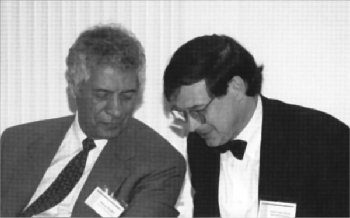
(L to R) Ishaq Nadiri of New York University and Jose Gomez-Ibanez of Harvard University
In fact, infrastructure investment has a negative impact on service industries in general, according to the Nadiri model. This is counter-intuitive, although there may be several technical explanations for this result. One explanation is that the model is based on average slope variables for classes of industries. The actual production functions of each individual industry may often differ from this dummy variable.
In some cases these negative impacts may be sensible. For example, some kinds of services might suffer if transportation was improved. This is because in service industries, the impacts of transportation costs fall on the customer rather than the business itself, unlike in a manufacturing industry. In addition, some industries do not utilize transportation infrastructure as intensely as others, although this does not mean that they do not benefit from highways at all. For the most part, the negative effects for service industries found by the model are small.
Another technical concern was that highway capital was not broken down according to its quality or the changing nature of the investment over the course of nearly forty years. For example, facilities built during the 1950s and 1960s were built using specifications that would be considered deficient by today's standards, such as standard lane widths, slope gradients, and curve radii. These standards impact the total capacity of a facility, especially as it reaches congested levels. If highway capital could be decomposed according to the types of project or by quality, it could provide more useful information.
In general, the historical patterns of the rates of return – high in the 1950s and 1960s, and lower but equivalent to private capital returns in the 1980s — suggest that the types and categories of investments undertaken may be crucial. In the first twenty years covered by Nadiri's analysis, the nation was making major expansions in the highway network. The question !s whether the nation can find similarly productive investments in terms of capacity additions in the future.
Professor Nadiri agreed that a careful assessment of future infrastructure needs is essential. But he concluded that, because the rates of return on infrastructure and private capital were similar, the stock of public investment in infrastructure should at least keep pace with the accumulation of private capital in order to achieve balanced growth.
Dr. Randall Eberts, who has long done economic research in this field, pointed out that earlier studies he had completed based on local rather than national data were consistent with the findings of the Nadiri study. In general, he found an elasticity of 0.03.
Dr. Eberts said that we need more research to find out "what is in the black box." In other words, we need to know how improved infrastructure is specifically translated into higher productivity for firms. Infrastructure investment in general must make business inputs more productive. For example, companies should be able to get their workers to the workplace more quickly. Better infrastructure should allow them to draw from a larger labor pool. Inventory can be transported more quickly and inexpensively as well. Improved infrastructure also attracts more companies because, he said, highway infrastructure is probably the number one attraction in the minds of local economic developers. It should also be kept in mind that infrastructure investment is a direct stimulus to growth for most regions. Most of the funding usually comes from outside the community.
Companies orient themselves spatially to the infrastructure that exists. It takes about ten years for a metropolitan area to adjust fully to a large infrastructure investment. There is evidence that high levels of public capital can raise productivity locally through economies of scale due to agglomeration, through higher land prices, and the ability to pay higher wages.
Research on whether infrastructure investment leads or lags economic growth has shown diverse results. One study found that economic growth in the southern U.S. would have occurred anyway even without infrastructure investment. That is, in the south, infrastructure investment may have followed growth. In northern states, however, it appeared to be the other way around. Infrastructure investment was more influential in raising the rate of growth. Eberts also found a correlation between infrastructure investment and openings and expansions of business. Such infrastructure investment also seems to slow down the pace of business closings.

Randall Eberts of the Upjohn Institute
"We need more research to find out what is in the black box"
- Randall Eberts
Professor Charles Hulten warned about making broad conclusions based on what he calls "uncut econometrics." The new statistical analyses produce an average constant relationship between infrastructure investment and productivity. But there is no reason to think that the average relationship is actually constant. In actuality, the relationship can vary across geographical regions, over time, and in different segments of the economy. Depending on all these criteria, infrastructure investment can produce high or low rates of return.
Dr. Hulten said that more research must be done in these areas. He suggested that public policy analysts and economic researchers should take into account three different mechanisms for determining how public investment may specifically affect productivity. The first is location theory. Why do companies locate where they do? Reduced transportation costs is one reason. There are also economies of scale and scope that accrue due to agglomeration. But this might be offset if a company's demand is spread over a large area. It will make sense to disperse locations under such circumstances. The rate of return on infrastructure investment may depend on the interaction of these three factors.

Forum Chairman Jose Gomez-Ibanez of Harvard University
"Professor Nadiri appears to have solved the essential problem associated with production function studies"
-Jose Gomez-Ibanez
A second consideration is that infrastructure investments are long-lived and ultimately serve users well into the future. In other words, capacity being built today is partly being banked for the future. Any correlation with contemporaneous growth is therefore questionable because much of the capital is not expected to be consumed until the future. Isolating such time-dependent effects will require more research. Also, it must be kept in mind that public and private investments may have different useful lives. This timing difference should be factored when comparing rates of return between the two.
The third consideration is how the network effect works. It is difficult to assess these effects. The same amount of capital devoted to two different locations may well result in vibrant network effects in one area and almost none in another. Early on in the development of such a system, as noted earlier, the network effect may provide large returns on investment as new roads make existing roads even more valuable. But there will often come a point when capital merely involves a substitution of new or different roads for older ones. At this point, returns can fall dramatically or even turn negative.
Professor Jose Gomez-Ibanez noted that Professor Nadiri appeared to have solved the essential problem associated with production-function studies. He observed that for the study to be praised even by skeptical and vociferous critics of previous studies, Professor Nadiri appears to have done an excellent job. But he also noted that this was nonetheless a pioneering effort, with some unexplainable features such as negative returns to service industries. Additional research in the following areas could further substantiate Nadiri's analysis:

(L to R) Colin Gannon of the World Bank and Charles Jacobson of Morgan, Angel and Associates
"In general, there has been a high social value from transportation investment"
- Colin Gannon
The World Bank has been involved in more than 1,000 transport projects throughout the world totaling about $50 billion of investment. For the most part, the World Bank assesses these projects on a "micro" rather than a "macro" basis. The objectives are to reduce transportation costs for the distribution of products, to improve access to the workplace for workers from a wide geographical area, and to improve access to the site for materials and other inputs. The World Bank also finances projects that specifically develop links from the farm to the factory, ports and onto international markets. To the World Bank, transportation investment is a key engine of economic development.
Colin Cannon, a senior transport economist at the World Bank, provided a table (shown below) of the rates of return on World Bank transportation investments that have been completed. "In general, there has been a high social value from transportation investment", he concluded. The projects documented below were largely undertaken in the late 1970s and early 1980s and the disbursement of funds was completed by 1994. The annual rates of returns are calculated at the time the project was completed, and then brought forward by making a forecast of supply and demand and the expected rate of return in the future.
The average annual return for all transport projects was 22%, similar to that reported by Nadiri. This was higher than the average annual return of 15% for all World Bank projects (within all sectors) over this period.
| Type of Project | Number of Projects | Annual Rate of Return |
|---|---|---|
| Airports | 8 | 21% |
| Highways | 306 | 26% |
| Rail | 72 | 14% |
| Ports | 96 | 20% |
| All Transport Projects | 482 | 22% |
| All Sectors | n/a | 15% |
In many countries the role of government is shifting from being the provider of infrastructure to being an enabler of infrastructure development. Creating too many governmental institutions can be inefficient. Maintenance is being badly neglected. The best route to the improvement of institutions may be carefully managed participation by the private sector with appropriate regulations. The role of the private sector as a partner or initiator of projects was embraced by several forum participants. In recent international research, the efficiency of local institutions appears to be highly important in determining the rate of return on infrastructure projects.
Looking backward in time, transportation investment was a key determinant of economic growth in the 19th and 20th centuries. During these formative years, transportation investment contributed significantly to growth. However, history also reveals many instances in which the nation made poor transportation investments. The most rewarding transportation projects were often the first and most innovative ones, such as the first canals and the early railroads. In retrospect, however, there has probably never been any one optimal transportation scheme. Many combinations of roads, canals, highways and rails lines may have worked as well or better than what was eventually built (Appendix B contains a bibliography of key historical works.)
An overview of international research on the effectiveness of transportation investment since the 1940s shows that these investments have often had substantial economic impact. This research was carried on in the U.S. and in a variety of countries. The use of production functions dominated the older research, but cost functions were occasionally also used. The standard measure of results were cost and output elasticities. Within the U.S., research was done on an aggregate nationwide basis as well as on a state-by-state basis. Similarly, research overseas was done on both a national and regional basis. Total public capital, transportation and highway capital, and other variations of infrastructure investment were the variables most frequently measured in these studies.
Statistical research was done as early as the mid-1940s to determine the influence of infrastructure investment on a nation's growth. The initial studies found that infrastructure was a positive catalyst for economic development in Eastern Europe and Third World countries. In the early 1970s, research done in Japan was the first to show that public infrastructure investment could contribute to a nation's productivity. This study concluded that the elasticity of output was high. The first study to find that public capital contributed to productivity in the U.S. was undertaken in the early 1980s. The elasticity of output was 0.05, similar to that reported by Nadiri. Aschauer's, and similar studies, such as those based on state-by-state research done by Alicia Munnel, were undertaken in the late 1980s. They concluded that elasticities were as high as 0.4 and 0.5.
The critical reaction to the Aschauer and Munnel studies has been intense, but has also provided positive results. Some of the critical studies yielded significantly lower cost and output elasticities, as well as lower rates of return than those found by Aschauer and Munnell. Nevertheless, many of these showed that infrastructure investment made a positive contribution to productivity. In sum, a wide variety of research shows that infrastructure investment is productive at the margin. Studies in other countries reinforce this suggestion.
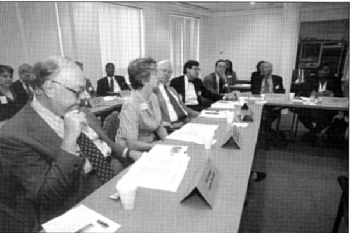
Edith Page of Bechtel Corporation addresses forum participants
Nevertheless, the wide range of different results for rates of returns and elasticities tends to diminish the confidence in this research. Dr. T.R. Lakshmanan of the Bureau of Transportation Statistics summarized this wide variation in previous studies conducted internationally. Appendix C contains a table which summarizes this information, part of which is included in the exhibit below.
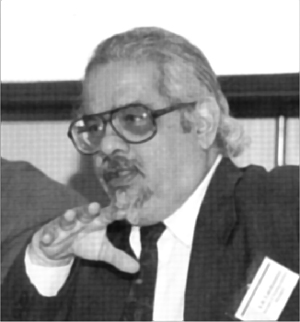
T.R. Lakshmanan of the U.S. Bureau of Transportation Statistics
"From now on there will be a fundamental distinction of 'before Nadiri' and 'after Nadiri' in the literature on the economic impacts of transportation investments."
- T.R. Lakshmanan
Some, but probably not all, of these variations might be explained by such effects as spill-overs from state to state and region to region. One of the contributions of the Nadiri model has been to resolve some of the fundamental concerns of earlier studies. Dr. Lakshmanan predicted, based on his reading of the new study, that "from now on there is going to be a fundamental distinction of before Nadiri and after Nadiri" in the literature on economic impacts of infrastructure investments.
Forum participants were eager to get beneath the broad, aggregate impacts and to determine how specific infrastructure investment decisions may affect the economy today. More complex times today stand in stark contrast to the simpler, more straightforward decision-making of the 1950s that was required to build the interstate highway system.
One major problem in applying the results of econometric research is that even rigorous regression analyses cannot unequivocally determine the nature of cause and effect. As noted by Robert Gallamore of Union Pacific Railroad, the ancient Greek philosopher Democritus said, "I would rather discover a single causal connection than win the throne of Persia." The question the forum faced is whether investment causes productivity to rise or is fulfilling existing demand that is generated by other forces, even though the research has demonstrated a clear-cut relationship between infrastructure investment and economic productivity. Citing the Princeton economist Albert Hirschman, Dr. Hulten noted that the rate of return is not necessarily what matters most in determining how important investment is for economic growth. What may matter most is whether investment "leads growth or follows it."
| Country | Sample | Type of Capital | Range of Elasticities |
|---|---|---|---|
| United States | Aggregate | All Public | Output: .05 to .39 |
| By States | Highway | Output: .19 to .26 | |
| By States | All Public | Output: .19 to .26 | |
| Japan | Regions | Transport, Communications | Output: .35 to .42 |
| India | Aggregate | Roads, Rail, Electric | Cost: -.01 to -.47 |
A good example is the high social returns on infrastructure investment in the 1950s and 1960s. Dr. Hulten said that the time may have simply been ripe for such investment as the American economy expanded rapidly towards the west and the south. How does one determine whether the same kinds of opportunities exist today? The forum agreed that more research into the value of specific projects and how they improve productivity is necessary. There was also widespread agreement that what should be avoided is a "field-of-dreams" approach — that is, just because we construct a facility does not mean that people will automatically come to use it to its full capacity.
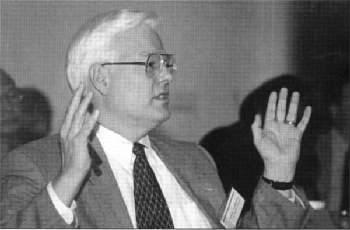
Bob Gallamore of Union Pacific Railroad
"Democritus once said, 'I would rather discover a single causal connection than win the throne of Persia'"
-Bob Gallamore
Tests and studies can be undertaken to try to isolate the question of cause and effect. For example, Dr. Eberts has conducted additional economic research to try to determine whether infrastructure investment leads or lags economic growth. So far, the research has found the effect can work both ways. According to one study, the growth in America's south would have occurred without infrastructure investment. In the north, however, it appeared that infrastructure investment did produce more growth. His research has also found a significant correlation between infrastructure investment and more openings of new business as well as expansion of existing businesses. He found evidence of the opposite relationship as well. Such infrastructure investment seems to slow down the pace of business closings. In general, however, research aimed specifically at isolating the cause-and-effect issue has found evidence that infrastructure investment both leads and lags economic growth, and may be both a cause and an effect.
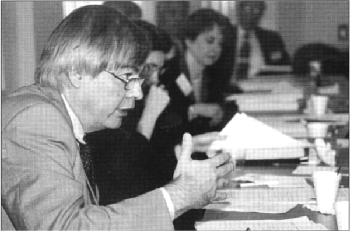
Charles Hulten of the University of Maryland
"What matters most is whether infrastructure investment leads growth or follows it."
- Charles Hulten
It should be clear that the same questions about cause and effect also apply to other types of investment, including private capital investment. Those who claim today that America does not invest enough in plant and equipment, for example, face the same issue. Is private capital investment a cause of growth or a consequence of it? One significant difference between infrastructure investment and private capital investment, however, is the time span of economic payoffs. Infrastructure investment creates conditions for growth that can extend well into the future. To measure the true pay-off of such capital investment is difficult. But it is clear that more than private capital spending, infrastructure investment, as Professor Nadiri noted, creates room for future growth.
What must be analyzed is whether creating conditions for future growth will be necessitated by demand. The Interstate Highway System is a successful example. It was underutilized initially, but created room for rapid future growth. But we do not truly know what would have happened had there been no such system. Further complicating these questions is the increasing role of services and telecommunications in the economy. This may reduce the need in the future for traditional means of transportation. Yet, an argument can also be made that they might increase demand more than expected.
The forum participants generally agreed that this is where the debate about economic returns centers. How do we utilize transportation best? Which transportation investments fit the "growing room" of today? This need should be coupled with the need to invest in new technologies — what Stanford economist Paul Romer has called "wetwear". One example of wetwear is the groundbreaking spreadsheet package Lotus 1-2-3. Another is intelligent transportation systems (ITS) technology. These new tools create whole new fields of economic opportunity. Many argue that privatization may be the best way to maximize the benefits of infrastructure investment.
Transportation shares many of the characteristics of new software. It has enabled corporations to take advantage of their existing technologies, as well as new technological developments. So investing in it is much like investing in wetwear–such improvements have the potential to have widespread impacts on many sectors of the economy.
The complementary relationship between transportation and communications, as noted, also needs to be better understood. Many of the benefits of infrastructure improvements have come from its complementarity with the information infrastructure. Looking to the future, particularly to the potential of intelligent transportation systems, this link could be crucial.
How do you select those investments that offer the most growing room for the economy? Looking to past experience, some government investments have been quite rational, but others not at all. Participants identified numerous examples which they felt were ill-timed. Econometric research cannot yet distinguish between periods of rational public infrastructure investment and irrational periods when specific investments are not fruitful. There were many similar mistakes made in the 19th century, often provoked by pork-barrel decision-making but also simply by duplicating what had already existed or once seemed to work. For example, many of America's early canals proved to be poor investments.
Ms. Gloria Jeff, the associate administrator for policy in the FHWA, pointed out that sometimes we do know what the alternatives would have been had the government not made the kind of investments it did. We don't always have to speculate about field-of-dreams exercises that are fictitious in nature. "There are living, breathing examples of alternatives," she pointed out. The southeast Michigan area and the metropolitan Toronto area were almost "twins" until after World War II. But Toronto did not invest in highway infrastructure to the extent Detroit did. Rather it invested in public transportation. "We know the results", she said.
The participants noted, however, that what might be right for one environment is not necessarily right for another. Detroit may have suffered from highway investment, but Seattle has thrived because of its highway system. What might be right for Phoenix is not necessarily right for Philadelphia. Solutions must be tailored to the local conditions that exist.
The World Bank tries to take such local considerations into account when determining what kind of infrastructure investment to make in developing countries. Cities in developing countries are growing rapidly and putting in durable infrastructure capital. But will they grow like Los Angeles or like Amsterdam? These are difficult issues to sort out, and only time will tell the results.
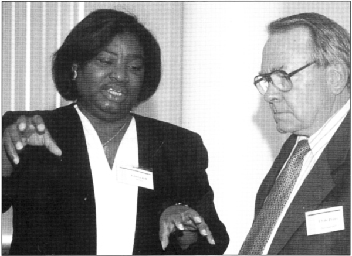
Gloria Jeff of FHWA and Clyde Pyers of the Maryland Department of Transportation
"'There are living, breathing examples...Detroit invested in highways and Toronto invested in public transportation. We know the results."
- Gloria Jeff
The distinction between visionary targeting of "growing room" and wishful "field of dreams" targeting may be even more difficult to make in advanced industrial nations. Transportation decisions have become extraordinarily complex in Western Europe, where roads are now crowded with trucks. Should these nations encourage short-sea shipping to reduce this congestion? More than at any other time in history, participants believed that vision is now required to make the right investment choices.
Obviously it is not always possible to accurately predict future conditions, but economists are typically very conservative, one participant noted. They want to know exactly what is going to happen. Nevertheless decisions must be made in real time, and in a different framework now than in the past. Therefore some level of uncertainty must be accepted as policy-making proceeds.
Private industries must also make projections about where transportation investments are most needed and most likely to occur. As a manufacturer of enzymes, Genencor International must analyze carefully where to place its distribution centers, for example. As the company has grown this has increasingly become an international question. There are four criteria the firm applies when seeking a location. The first and most pertinent is the quality of the infrastructure that is already in place in the area. Genencor situates distribution centers only in locations with a highly dense transportation infrastructure. The other criteria are the ability and availability of the work force, the sophistication of information systems, and taxes, customs and other trade regulations.
One reason Genencor placed a distribution center in Rotterdam, for example, was that it was able to find enough information to give confidence that the infrastructure was adequate. The company could judge the density of infrastructure, including the number of seaports and activity in those seaports, measured for example by the number of containers that go in and out. Information regarding the freight tonnage handled by the airport allowed Genencor to make an "educated decision" rather than merely a guess about the merits of the location. In sum, Genencor will only locate where infrastructure is currently adequate, not where it must await further development.
General Motors spends about $4 billion a year in direct outlays to transportation companies. GM utilizes about 15,000 vehicles daily, many of them tractor-trailers, to handle GM products in the fifty states. Speed of delivery is now the driving force behind many of GM's decisions because of the emphasis the industry places on inventory control and the resulting need "to synchronize transportation with manufacturing cycles."
Highway congestion is becoming an ever-bigger problem for GM as a major shipper. GM is trying to encourage railroads to improve their efficiencies in order to create competition for motor carriers and also to relieve congestion on the road. Currently, shipments to GM via rail average a speed of only about six miles per hour on some links. GM would like to increase that to twenty five miles per hour.
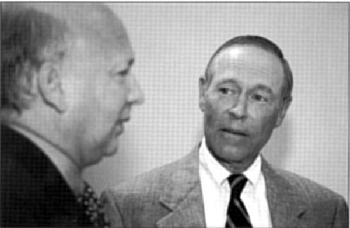
Jeff Madrick and Joe Clapp of Roadway Services (retired) discuss how transportation investments affect business
On the other hand, GM makes highly efficient use of motor transport to meet their just-in-time inventory requirements. One truckload of materials now travels between Windsor, Ontario and Detroit eight to ten times a day. A truck can make the trip across the Ambassador Bridge and through Windsor and Detroit in only forty minutes. This is remarkable given the density of both Windsor and Detroit. One main reason for the efficiency are the improvements that have been made to the Ambassador Bridge. GM is working with the city and state to improve further the access to the highways that serve the bridge. This will not only improve speed, but also increase safety by reducing the number of tight turns.
Another example of how important transportation infrastructure is to making location decisions for plants in the auto-manufacturing industry is Toyota's decision to build in Indiana and West Virginia. These decisions were probably driven by transportation considerations. Intermodal transportation promises to be increasingly important for the auto industry in the future. GM has a joint effort underway with the three U.S. auto companies to put up a facility that can coordinate rail and motor vehicles.
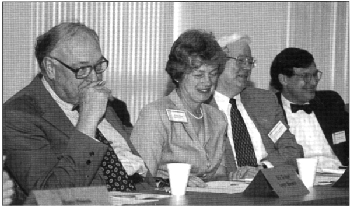
(L to R) Eric Beshers of Apogee Research, Edith Page of Bechtel Corp., Bob Gallamore of Union Pacific Railroad, and Jose Gomez-Ibanez of Harvard University
GM is not putting more effort into trying to relieve congestion on the roads because it believes that congestion is inescapable. For example, some forecasts predict that Dayton, Ohio will be completely gridlocked by the year 2000 or 2010. The ensuing discussion pointed out that new railroad lines may still be stuck with local congestion to and from the rail head.
Some investment firms are working with private companies to build their own infrastructure. Lehman Brothers has teamed up with Walt Disney Co. in Florida, for example, to put up infrastructure rather than the local government. GM has long put in lanes and bought property around their plants to ease access, although the company has not yet looked into private investment in order to reduce bottlenecks along the delivery lines.
The results of some of the research suggest that the use of general obligation bonds to finance local and regional projects makes sense. The research implies that there are significant network benefits, as noted earlier. An entire community benefits from such pooled investment. However such investments are usually financed through revenue bonds. These bonds are often backed by toll revenue or other user fees. But given that they may have broad benefit for the community, as the new econometric research suggests, other ways to finance them may be practicable. New financial tools such as Section 1012 loans and state infrastructure banks can be used. One important new trend is to get private industry involved, show them how they will benefit, and encourage them to pool together to make a project work.
The Stark County Intermodal facility in Ohio is an example of such a public-private partnership. One company in this area threatened to move out of the community if it couldn't get a $35 million intermodal service facility built. But this company alone could not provide sufficient demand to convince the railroads that they should make the investment. A group of companies was ultimately combined to guarantee to the railroads that demand was sufficient to make a $24 million investment in the project. The remaining $11 million was borrowed from the state DOT. Every time a box moves through the intermodal facility, the state DOT is now paid a dollar.
One concern expressed at the forum was that much of the discussion focused on the manufacturing industry while the U.S. economy is now dominated by services industries. Participants noted that service companies might well assess a location decision differently than a company such as GM would.
But others indicated that because services industries require large numbers of workers, or often serve many customers, efficient transportation could be even more important to them than to manufacturers. In fact, many services companies have benefited from better transportation systems. Walmart, for example, has become the world's largest retailer in part because of its transportation logistics. The slow growth in consumer price inflation in the economy in general may partly be the consequence of improved logistics at retail outlets.
Indeed, logistics costs as a percentage of GNP have fallen from 17.2% in 1980 to 10.4% in 1995. This has resulted in a $68 billion a year savings to the economy. What accounted for this? Much of it may have been attributable to the deregulation of trucking, according to one participant. But participants pointed out several other contributory factors. Logistics costs were driven down by the building of hundreds of industrial parks across the country with efficient transportation systems. High interest rates in the 1980s especially motivated businesses to seek more efficient transportation in order to keep inventory costs low. There are many other examples of how industries have changed the way they do business to accommodate their transportation needs, including new transportation systems, as well as new technologies involving everything from electronic just-in-time inventory controls to high-speed coordination between suppliers and manufacturers.
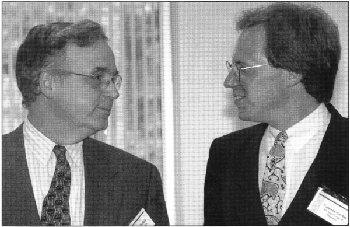
Dick Mudge of Apogee Research and Cameron Gordon of the University of Southern California
Nevertheless, different kinds of transportation systems might be necessary for services industries. The FHWA has recently initiated a program to improve the estimates of service sector total factor productivity. This may improve future research in this area.
While participants agreed that there is more research to be done, there was widespread agreement that the new research has important implications for future policy. Does the research change the emphasis the government should place on its own transportation objectives? How can the government ensure that the right kinds of infrastructure investments are being promoted? Finally, how can the importance of infrastructure investment to the economy as a whole be articulated to a larger audience, especially as we face the reauthorization of ISTEA?
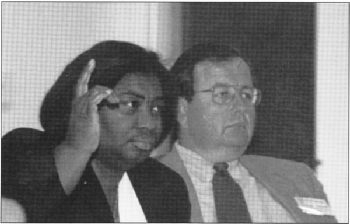
Gloria Jeff of FHWA and Ron McCready of the Transportation Research Board
The new research doesn't only imply that new infrastructure investment can promote economic growth and productivity. It also implies that if capital stock in infrastructure falls, productivity will be reduced. The cost and output elasticities imply that a dollar less capital stock will reduce output, income and consumption as much as a dollar of increased investment will raise it.
The FHWA finds that demand is vastly exceeding additions to highway capacity, even though this capacity is rising by 3% a year. Capacity is also being raised by the addition of HOV lanes and local projects. Nevertheless, Ms. Gloria Jeff of FHWA pointed out that we don't know what will happen if the nation doesn't invest more in capacity but simply concentrates on maintenance and improving efficiency. Other participants noted that we are not thinking about requirements in fifteen or twenty years, not to mention in just five years.
The FHWA has made economic prosperity one of its five main principles for future transportation policy. These objectives are:
In determining how to meet the last objective, many participants agreed that it is not necessarily aggregate demand that is most important. The key question is whether transportation investments are targeted in the right locations and times in order to achieve the highest returns within their respective contexts. Another participant urged the government to keep economic research in "context, context, context." In the current environment, he pointed out, maintenance and managerial issues are what keep coming up. Rather than more investment, people are increasingly talking about disinvestment.
Ms. Jeff noted that the FHWA traditionally has taken a "micro" view of the impact of infrastructure investment. This has usually involved a cost-benefit analysis of specific projects and their immediate effects on localities. In the past, FHWA asked how highway system users would benefit directly from transportation systems. Now, the agency must take a more macroeconomic point of view. The agency asks not only how a transportation system can help companies and workers live better and safer lives, but also how it affects their economic well-being in general.
How can the advantages for the general economy of infrastructure investment be better communicated both to lawmakers and the public? One example of the difficulty is that transportation did not appear as an issue in the Presidential primaries nor has it appeared in the Presidential election race, either. One reason is that transportation issues rarely if ever appear on national polls. This stands in stark contrast to the interests of local communities, where transportation issues do often rank high in the polls. New roads, widenings, truck traffic volumes, congestion and related issues come alive and are concrete at local levels. Localities often vote to finance such projects. When they are raised to a national level, however, these concerns become generalized, abstract, and vague.
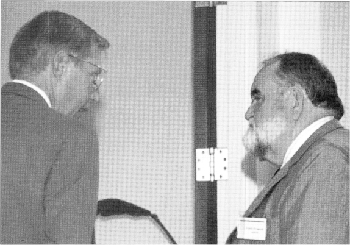
Damian Kulash of the Eno Foundation and Frank Francois of AASHTO
"Congressional Leaders are beginning to ask how productivity can be improved by highway investment."
- Frank Francois
This wasn't true historically. In the 1920s, for example, people knew what they wanted from roads. We had to get America out of the mud. In the 1950s, America knew it needed highways. Today, with the Interstate system completed, it is more difficult to explain why investment in highways makes sense. Safety and congestion are two Issues that carry weight with people in general, but little else does.
On the other hand, some participants said there is a demand for more information that would demonstrate the impact of infrastructure investment on economic growth. Frank Francois of AASHTO reported that his organization believes economic returns should be part of the argument. He has found that Congressional leaders are beginning to ask how productivity can be improved by highway investment.
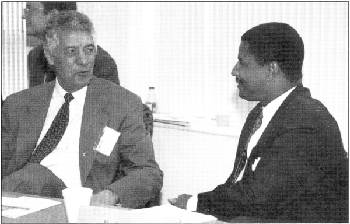
Ishaq Nadiri of New York University and Rodney Slater of FHWA
"The analytic challenge is to see whether the quality of services provided by this type of infrastucture is adequate to meet future needs."
- Ishaq Nadiri
This most recent research, and the work of others, can be used to fill this gap. In the Nadiri model, social returns for non-local highway investments averaged well above returns on private capital investment, as noted. In general, even though returns have fallen over the past forty years, they are the equivalent of returns on private capital.
For all their encouragement, however, participants urged that the results of the new research should not be overplayed. Credibility is very important. The results should be neither over-simplifed nor exaggerated.
After several years when research about the effects of infrastructure investment on U.S. economic growth, productivity, and rates of return had little credibility, new research has now reinforced the view that infrastructure investment plays a significant role in the nation's economic health. The new work by Professor Ishaq Nadiri, in addition to a wide range of historical and international studies, finds that social rates of return on infrastructure investment are significant and positive. They were very high in the 1950s and 1960s, and comparable to returns on private investments in later decades. The research concludes that infrastructure investment has helped raise the nation's productivity and reduce its costs of doing business.
The impacts of transportation vary widely from time to time and from place to place. Rates of return and cost elasticities that come from economic analysis represent average relationships that, in fact, usually vary over time. Most notably, social rates of return have fallen rapidly during the period under study. These returns also vary according to place and the economic environment. The first roads in a region may provide especially strong returns, for example, but eventually new roads are merely substitutes for older ones as localities mature. Returns naturally fall. To maximize the positive economic impacts of transportation investments, we must examine how and when this effect is likely to occur.
Network benefits are especially hard to measure. The new research strongly suggests that they exist — that is, that industries benefit from shared capital investment. But there are dynamic effects that are difficult to assess. One of the most important of these is that infrastructure investment, more than most other types of investment, creates conditions for future growth well into the long run. Not only are these benefits especially hard to estimate: because the total payoffs for such public investment are rarely immediate, they also do not receive much attention from the political system. But they are the key to making successful transportation investments.
In sum, transportation investments have had broad positive impacts upon the economy in general. Future infrastructure investments can also produce sizable returns, but only if they are the right investments at the right time — investments that create growing room; investments compatible with the institutional context. The fact that policy makers appear to have selected such investment in the 1950's and 1960's does not tell us much about what the best opportunities are today. The challenge facing the nation now is to determine how to choose the best infrastructure projects to enhance our growth and productivity.
There are several implications of these results for future transportation policy. First, the objective of public investment in infrastructure is not simply to solve a locality's immediate transportation problem — be it potholes or congestion. Rather, it is to enhance the general prosperity of a region and the nation as a whole. Neglecting public investment in infrastructure can retard economic growth and diminish the nation's productivity. Second, more analysis should be undertaken about the specific conditions needed to maximize the value of investment projects. Third, new means of financing can be linked to the broader economic payoffs of such investments. Finally, these conclusions need to be phrased in a credible, specific vision to guide future transportation policies and investment decisions.